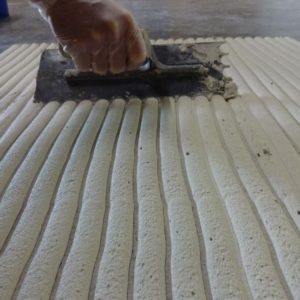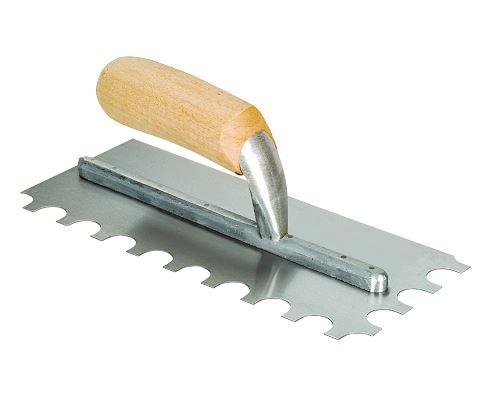What You Need to Know About Thinset or Mortar
Posted by TOA's Blog Team on Apr 20th 2023
Do you know the difference between thinset or mortar and grout? Both are critical, but they each play different roles in a tile installation.
What is Grout?
As we explained in Why You Need Grout When You Install Tile and Stone, grout is used as a filler for the joints between tiles once the tile you are installing has been set. Most grouts are a powdered mix of cement, lime, color pigment and sometimes sand that hardens when mixed with water and left to cure.
Grout gives your floor or wall a crisp finished appearance. It helps keep dirt and debris from getting in between and under your tile and it adds rigidity and strength to the tile installation.
>> Also see Frequently Asked Questions About Grout
Two TEC Specialty Product Grouts
In this blog article, you'll learn more about two different grouts from TEC Specialty Products available from Tile Outlets of America: Power Grout and Design FX Grout. Let's explore each one.

1. TEC Power Grout #550:
TEC Power Grout offers many benefits to a tile installation. It provides superior performance in wet and dry areas including both residential and commercial applications.
It's stain proof, and never needs sealing. It's also mold and mildew resistant, and crack and shrink resistant.
This product is a fast-setting grout, and can be walked on in 4 hours. We strongly recommend that you mix Power Grout in small batches, smaller than you might with typical grout. This is due to the fast setting nature of the product.
You'll find that it has accurate color uniformity, and zero efflorescence.
You can use TEC Power Grout for both interior and exterior installations, and on grout joints from 1/16” to ½” wide.

2. TEC Design FX Grout # 546:
The next grout product is TEC Design FX Grout.
It's easy and ready to use, and ideal for adding sparkle, shine, and a little “bling” to your grout.
You'll find that it's perfect for grouting the following types of tile:
- Ceramic
- Porcelain
- Glass
- Metal
- Most types of natural stone
Design FX is stain proof as well as mold and mildew resistant. It is color consistent with no efflorescence. You can apply it for both interior and exterior use projects.
Please note that we recommend the following materials for grouting: grout gloves, a urethane grout float, a clean grout sponge, and a white fine nylon scrub pad.
These items will provide you with the ability to apply and remove excess grout from the surface area(s) with minimal effort.

What is Thinset or Mortar?
Thinset, on the other hand, is used to install tile over cement, cement/fiber board and anti-fracture/water proofing membranes. It is what makes it possible for tile or stone to stick or bond to the backer board.
Thinset or mortar (or thinset mortar, thinset cement, dryset mortar, or drybond mortar) is an adhesive made of cement, fine sand, and a water retaining agent such as an alkyl derivative of cellulose.
Many thin-sets have latex and polymer additives in them designed to increase bonding strength.
As tile sizes get larger and longer, adequate mortar coverage becomes increasingly critical.
Which Thinset Applies to Which Type Application?
Don't assume that any thinset will do for your tile installation project. Based on the characteristics of your individual project, you'll find that there is a specific thinset to use for that application.
The type of thinset needed for your project depend on a number of things.
- What type of material are you installing (ceramic, porcelain, natural stone, glass, metal, pavers, etc.)?
- What kind of substrate it is going over (existing tile, terrazzo, cement, wood, cement backer board, etc)?
We definitely recommend that you speak to a Tile Outlets of America sales representative and explain the project details, including any materials being used and we will help you select the correct product.
TEC Mortars to Consider
Here are TEC Specialty Products mortars that you'll find available at Tile Outlets of America.

1. Ultimate 6 Plus Mortar # 487:
Ultimate 6 Plus is a polymer-modified high performance mortar with exceptional non slag and slump characteristics. It's ideal for installing LHT (large heavy tile) including:
- Gauged porcelain
- Ceramic
- Glass
- Stone materials
This product has been tested and approved for installing tile on uncoupling membranes. It reduces the need to back-butter tile and it features an extended open time when mixed while providing the ability to be grouted in 6 hours.

2. Permaflex 300 LHT #044/045:
Permaflex 300 LHT is a quality thinset mortar that is essential for installing large heavy floor tile. Bedding thickness can range from 3/32” to ¾”.
It is ideal for installing the following types of tile:
- Ceramic
- Porcelain
- Quarry
- Cement tile
- Pavers
- Een light colored glass tile
It works for both interior and exterior use.
When grouting it is recommended to use a grout float. This tool will provide a smooth surface to properly spread the grout into the grout joints, and not scratch the tile.
Don't forget to select the correct trowel size!
Make sure to select the correct trowel size for your project regardless of the type of tile installation you are undertaking.
You'll want to use a smaller trowel for small tile and a larger one for large tile. Use a trowel that will help you achieve a continuous minimum 3/32” coverage.
Larger tiles most often require deeper notched trowels.
>> See 9 Top Questions About Trowels
How should you mix thinset?
In many ways, you'll want to mix thinset the same way you mix grout: pay close attention to the manufacturer's instructions.
Always double check the manufacturer's instructions on the tile you purchase for exact product requirements and installation guidelines.
You need to use the appropriate thinset mixing paddle.
Thin-set should be mixed to the consistency of peanut butter. While specific instructions vary by manufacturer the basics are the same.
- Dry thinset and water should be mixed in a bucket in stages.
- A whole bag should never be mixed at one time.
- Add about half of your water to the bucket, then add some thinset and mix.
- Keeping adding thinset until you reach the correct consistency.
- Let the material slake and then remix and you are ready to go.
Due to its cement ingredients, thinset should be made up in small batches as needed. It also should never be washed down a drain, as it will harden in your pipes.
How should you apply thinset or mortar?
When spreading thinset, don’t spread any more on the floor or wall than you can work in a few minutes. Thinset dries very quickly once it’s troweled out.
Proper mortar coverage is critical to preventing failures. According to the ANSI and the TCNA Handbook, tile requires a minimum of 80% mortar coverage in interior applications, and 95% for exteriors and wet environments. Natural stone tile requires 95% coverage in all areas.
Mortar coverage becomes particularly important as tile sizes get larger and longer (think wood plank tile). This applies to any tile with any side 15 inches or longer. What seems to work for small tiles no longer works.
>> See An Introduction to Tile Warpage and the Role of Mortar
As a recap, be sure to:
1. Prep your installation surface so it is flat.
2. Make sure that you get proper mortar coverage on the tile. Start by keying the thinset in to the substrate using the flat side of the trowel. (Keying or burning in allows the tile mortar to bond better with the substrate by increasing your bond to the pores or texture of the substrate. Hold the flat side of your trowel at 45 degrees to the substrate and pull towards your body changing direction with each pull leaving a thin layer behind.)
3. Don't swirl the mortar!
4. "Play it Straight!" Comb the mortar in straight lines
5. Backbutter the tile
6. Move the tile in one direction to collapse the mortar ridges
7. Trowel size matters
8. Don't ever spot bond tile!
>> See How To Install Tile Correctly and Get Proper Mortar Coverage
What questions about thinset or mortar do you have?
Let us know if we've missed a question you have about thinset or mortar and we'll add it to this article.
Or, simply visit us in-store and ask us.
Please be sure to visit your local Tile Outlets of America location. We are located in Ft. Myers, Tampa, and Sarasota, and offer many resources on the TileOutlets.com website.
Thanks for reading!
Note: We originally published this article on July 6, 2017, and have updated it.




